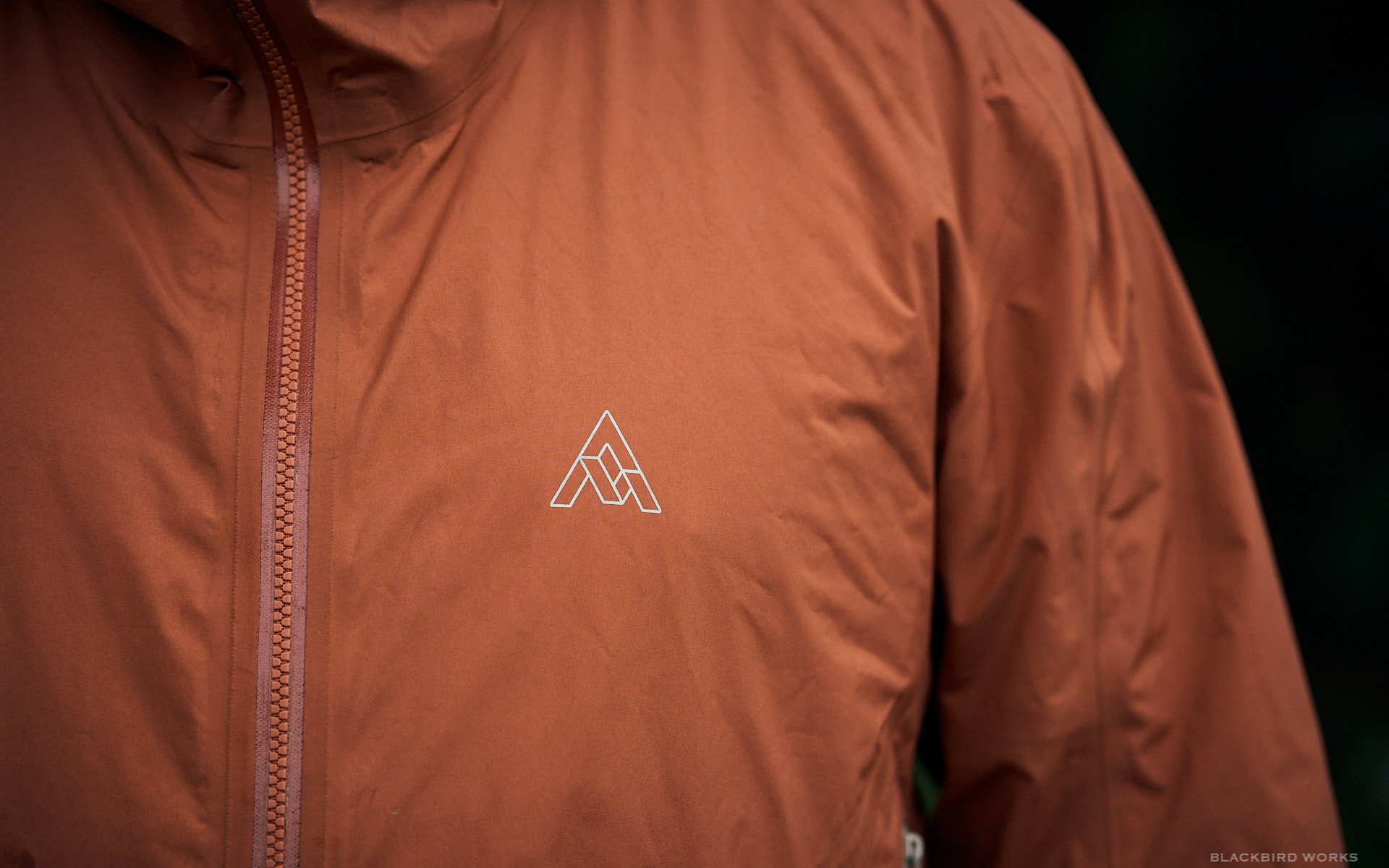
REVIEW
7Mesh Copilot Jacket Review
The 7Mesh Copilot is designed to be a lightweight, packable layer that'll save your ass in an emergency squall but will otherwise happily ride shotgun in a jersey pocket or bag until you need it, without adding much bulk or weight to your load. Based on this premise, it does its job admirably. Expectations are justifiably high for a jacket with a 7Mesh logo on the chest and constructed using GORE-TEX Paclite Plus, but the Copilot lives up to its billing and then some.
Cam recently wrote about the 7Mesh Skypilot, the Copilot's fully-featured counterpart that is constructed using Gore-Tex Active, a 3-layer sandwich (Paclite Plus utilizes a 2-layer construction). At face value, both jackets are quite similar until you break down the details and, unfortunately, 7Mesh didn't help us by naming both jackets so similarly. Skypilot is $450 CAD and Copilot (featured here) is $300 CAD. Neither are inexpensive but both offer good value - that is the nature of a well-constructed jacket that uses Gore-Tex to keep the elements at bay.
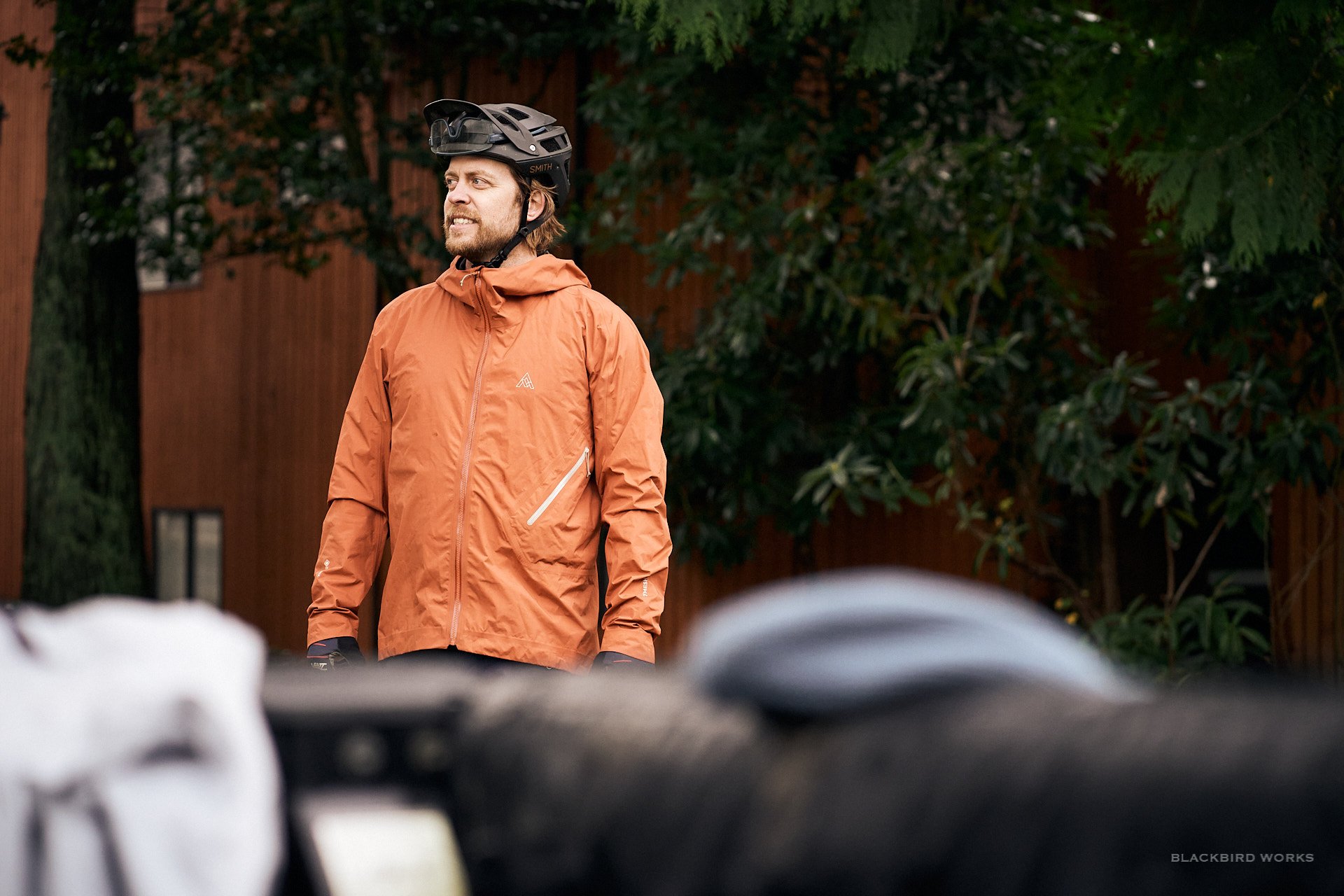
The 7Mesh Copilot in Brickwork, size L. It also comes in a very nice second colour called Slayter Blue.
7Mesh Copilot vs Skypilot
Whereas the Skypilot Cam tested is intended for more regular use while the Copilot (and Paclite Plus garments in general) are designed to be a 'backup layer' that is there when you need it, that doesn't mean you can't consider the Copilot to be your principal riding jacket. GORE-TEX's language can be a little difficult to sort through and most brands don't do a very good job of helping decipher, but think of it this way: both Gore-Tex Active and Paclite Plus are light and breathable, and neither are as durable as Gore-Tex Pro. They are, however, intended to be worn for consistent high output activities like riding or running, whereas Pro excels in environments that demand more durability - like skiing or mountaineering - which usually also means more stop/go activity.
The average rider on a 1-3 hour ride is going to be well-served by Paclite Plus or Active, but if you were an MTB guide that spends long hours in all conditions - like the BC mountains or, say, Scotland - you might go for something constructed using Gore-Tex Pro. I've been on plenty of rides where the added weight and bulk of Pro is appropriate but in recent years have concluded that 95% of my rides - even in the rain - don't require that much protection, especially since we all dodge the rain as much as possible, when we have the ability to be flexible with scheduling. If you tend to ride within strict time windows, you may prefer the added protection of Pro. If your rides don't involve a lot of stopping, or you can dodge the worst weather as a general rule, favour less bulk and need a layer that has your back when you need it, but is just as often an insurance policy - the 7Mesh Copilot is going to be a good option for you.
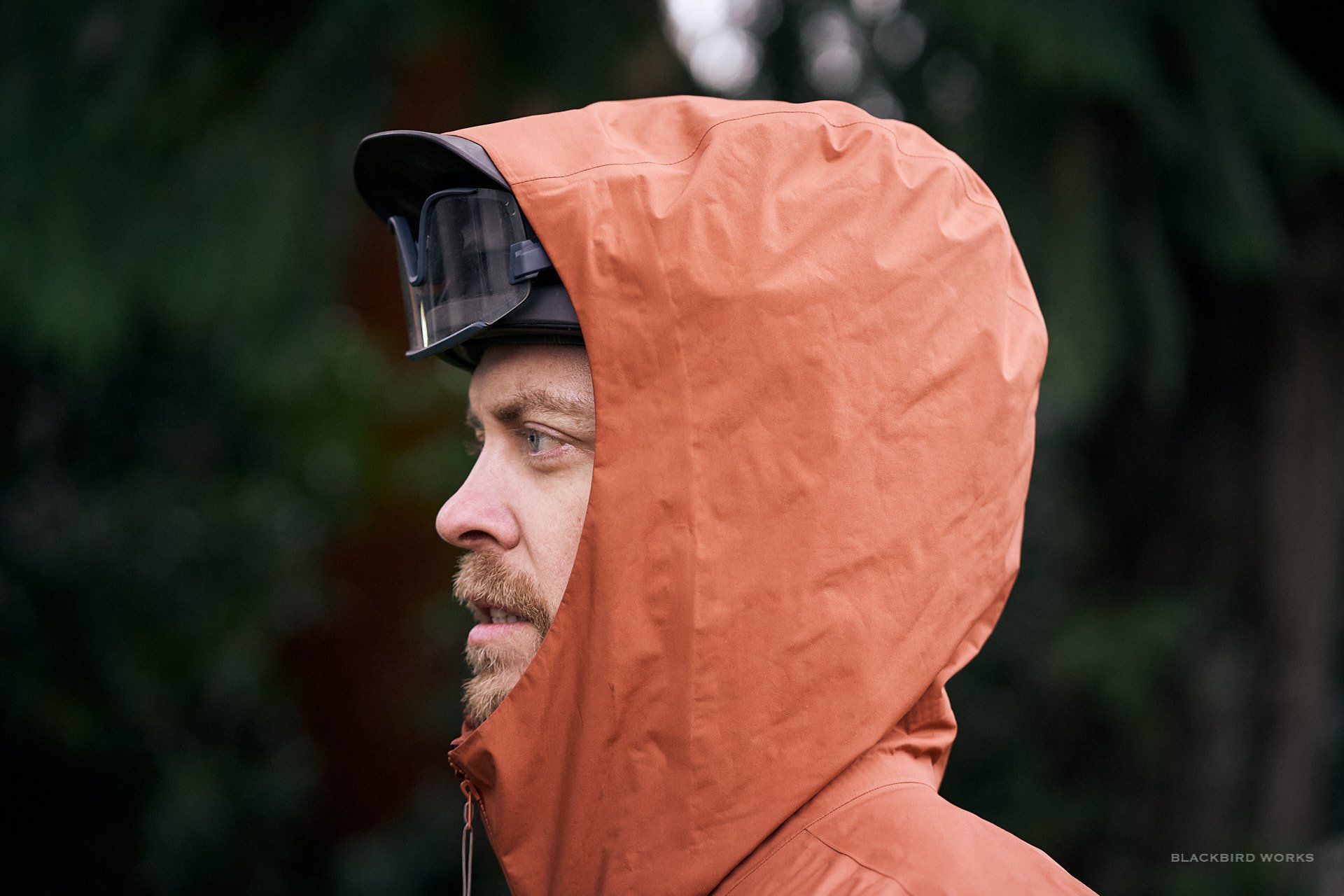
The Copilot's hood fits comfortably over a helmet - a change of pace from their early jacket designs that used an under the helmet style that most riders I know don't like all that much (me included).
Putting the Copilot into hard use
Of course, I threw that all out the window when testing the 7Mesh Copilot, because the question I most wanted to answer was whether this one layer could satisfy most of my needs. On one occasion I left early to beat the worst of the rain, starting from home and pedaling up towards Mt Fromme with a 90-minute ride in mind. The rain started after no more than 300 meters down the road. "Fine," I thought, "good chance to test this jacket." I had dressed lightly so I could wear it from the start, rather than relying on it later. Within minutes I had the hood up for maximum protection, and water was funneling off every surface of both rider and bike. The forest canopy provided some cover, but I continued to be pelted until...I hit the snow line. The Copilot had, so far, kept me completely dry, and after 30 minutes of climbing I was concerned about getting wet from the inside, but it didn't happen - I remained dry and even though I was sweating, I had nailed my layering and everything was being moved efficiently to the outer layer. I was so comfortable, in fact, that I rode until the snow made pedaling impossible, and then I pushed up even further, just to see what a certain trailhead looked like (and because I was all alone up there and just wanted to go higher and further).
I finally got to the top of my climb and despite thinking the Copilot had already passed a fairly ultimate test with flying colours, there was one more gauntlet to endure. After taking a few photos and enjoying the silence, I set off down the hill - only to wrench a massive stick through the rear spokes, mangling a derailleur in the process. The fix took 20 minutes longer than it should have, because my bare hands started betraying me halfway through the repair. On a typical mid-winter ride, I would have been freezing cold by the end of that situation (fingers notwithstanding). Instead, once I finally began my long and continuous downhill (capped off by 25 blocks of steep descending through city streets at 40-50 kph), I remained comfortable and stayed that way until the end, some three and a half hours later.
Since that ride, I have had several others that allowed the Copilot to really earn its keep, and I'm now very happy to 'be bold, start cold' even on rides where there will be starting and stopping, or when the weather calls for rain and snow. For a 'backup layer' I'm happy to report that the Copilot is everything I could ask for and more which, again, is a fair ask at 300 bucks.
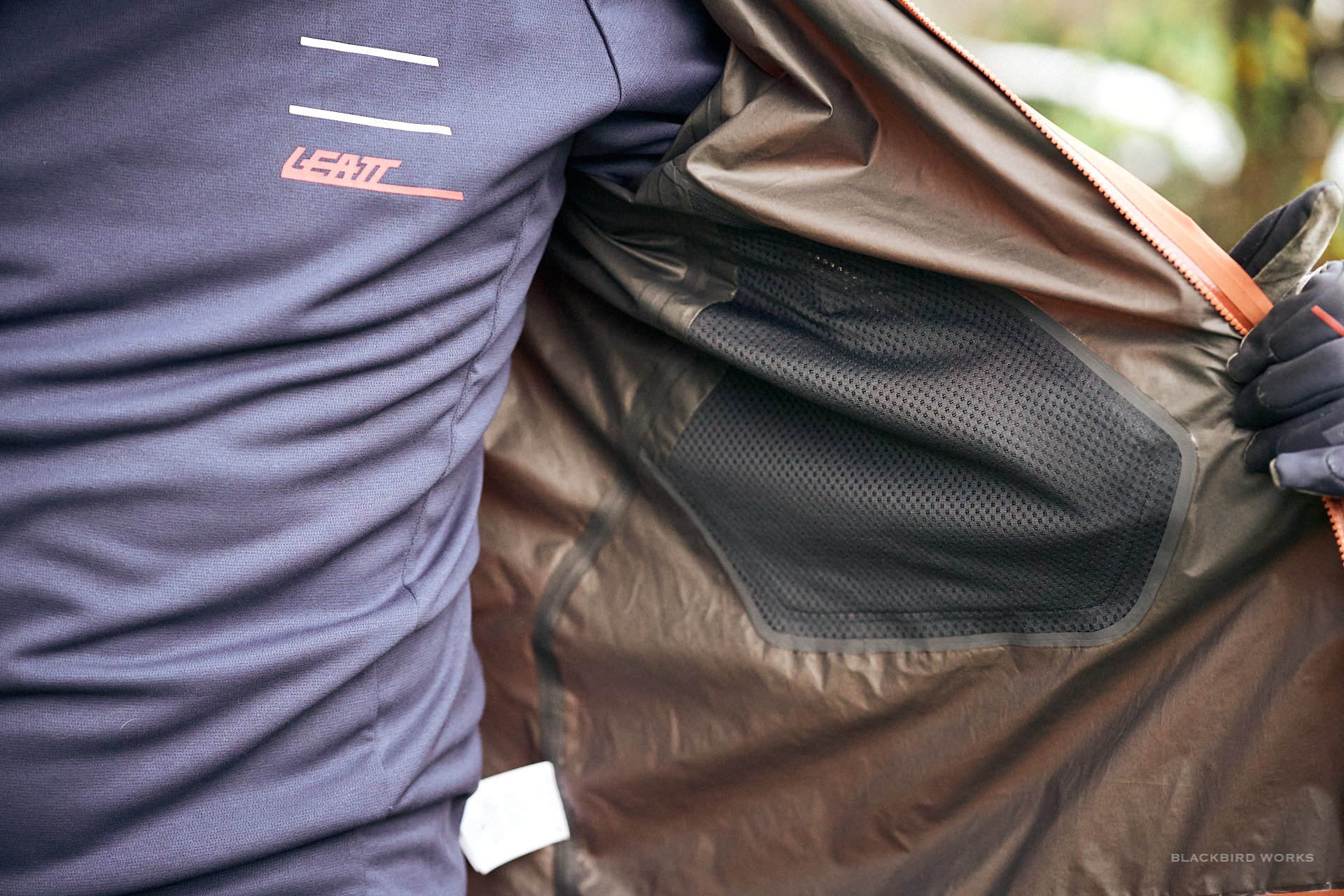
A look at the taped seams and inside of the Copilot's singular pocket. It's not as good for a phone as a Napoleon pocket, however my guess would be that 7Mesh doesn't like Napoleon pockets because when you're bent over the bars, the pocket's load would pull down, and they're intent on creating a streamlined look and feel with their garments.
Copilot Details & Fit
Owing to its intended use - to be light and packable as well as breathable in nasty weather - the Copilot isn't blessed with a lot of pockets, but that doesn't mean it isn't feature-rich, just that they're all subtle. By 'not a lot of pockets' I mean there is but one, and it's only really accessible by reaching across your body with your right hand to get to it via the watertight 2-sided zipper. This works fine when you're on the bike - allowing you to grab some food or a phone - but is otherwise one of those bike-specific design choices you'll question if you wear the Copilot while doing something else. That same pocket doubles as a pouch for the jacket if you want to stuff it in, but I prefer using a sleeve as a pouch for all my jackets, turning them into wet weather salvation in the form of a burrito. I find that shape to be more packable than the rounded rectangle of the Copilot's lone pocket, and you can grab the cuff and flick your wrist to deploy your jacket burrito instantly.
Continuing on with the minimalist theme, the cuffs bear no closures but have lightly elasticized undersides and are shaped to cover your wrists perfectly when your hands are on the bars without bunching up. It's a small detail you really appreciate as the rain probes every nook and cranny while you tell yourself over and over what a hard ass hero you are for being out there on your bike in the rain.
The hood fits over a helmet and has 3-way draw cords to help keep it in place. The drop back hem gives your backside a bit of extra coverage without looking like a dorky 90s era commuter jacket, and there is a draw cord at the hem to cinch it up, which I haven't used because the size L I'm testing is a long Large which, in some photos, looks a bit barrel-like, in stark contrast to certain 7Mesh jackets of old that were decidedly tapered. At 6'1 and 190, I'll take this more relaxed fit, but as someone with a long torso (and none too svelte), it's worth pointing out that I could probably make a medium work, whereas in the past a 7Mesh medium was tight on me. It does not feel bulky or baggy in the least, it's just worth noting.
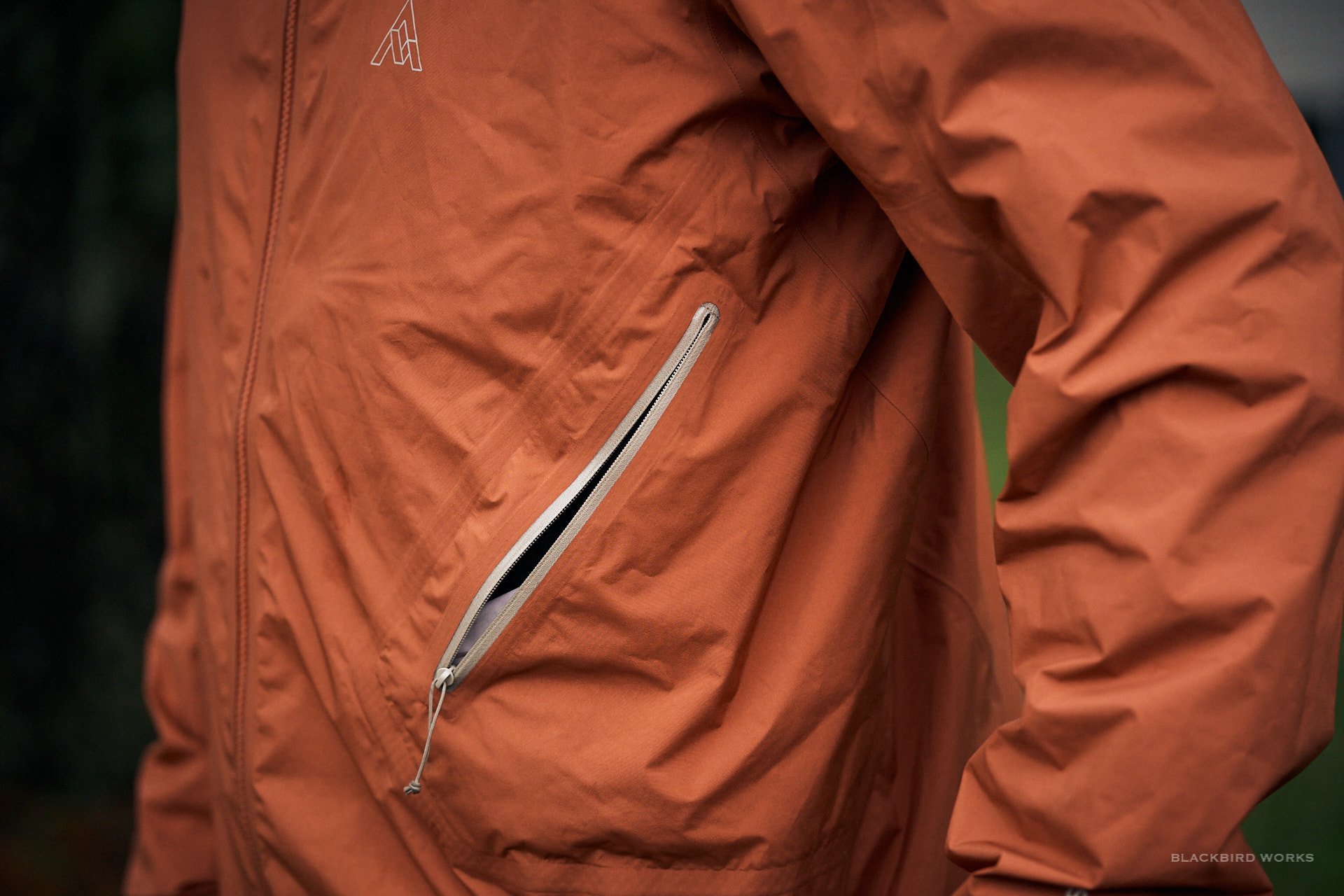
One pocket only, and it works well on the bike, but is hard to access when you're not riding. The watertight zipper does its job and isn't overly hard to open. The Copilot's graphic accents are all reflective.
It is easy predict that some will complain that even at $150 less than the Skypilot, the Copilot still costs too much. I would argue that for many users, however, this piece will keep you dry and comfortable in truly shitty weather, while also being easy to fit in a jersey pocket, hip pack, or SWAT box, where it will serve as insurance against a ride ending prematurely or in misery, for years to come. Those concerned about damaging their investment will be glad to know that 7Mesh's crash replacement policy should provide added peace of mind. There are less expensive jackets out there, but they likely won't feature a GORE-TEX membrane or 7Mesh's careful design details and fit, so you may find some degree of protection from the elements, but not the same level of breathability or comfort. If you really only need a jacket very rarely, you can surely get away with less. For the weather we see here on the North Shore, the 7Mesh Copilot feels like $300 very well spent: it'll get you out riding in bad weather, or keep you out there, and do double duty as an emergency layer for hikes or anytime you're in the forest or mountains and need good protection without the bulk or weight of a less expensive, less effective option.
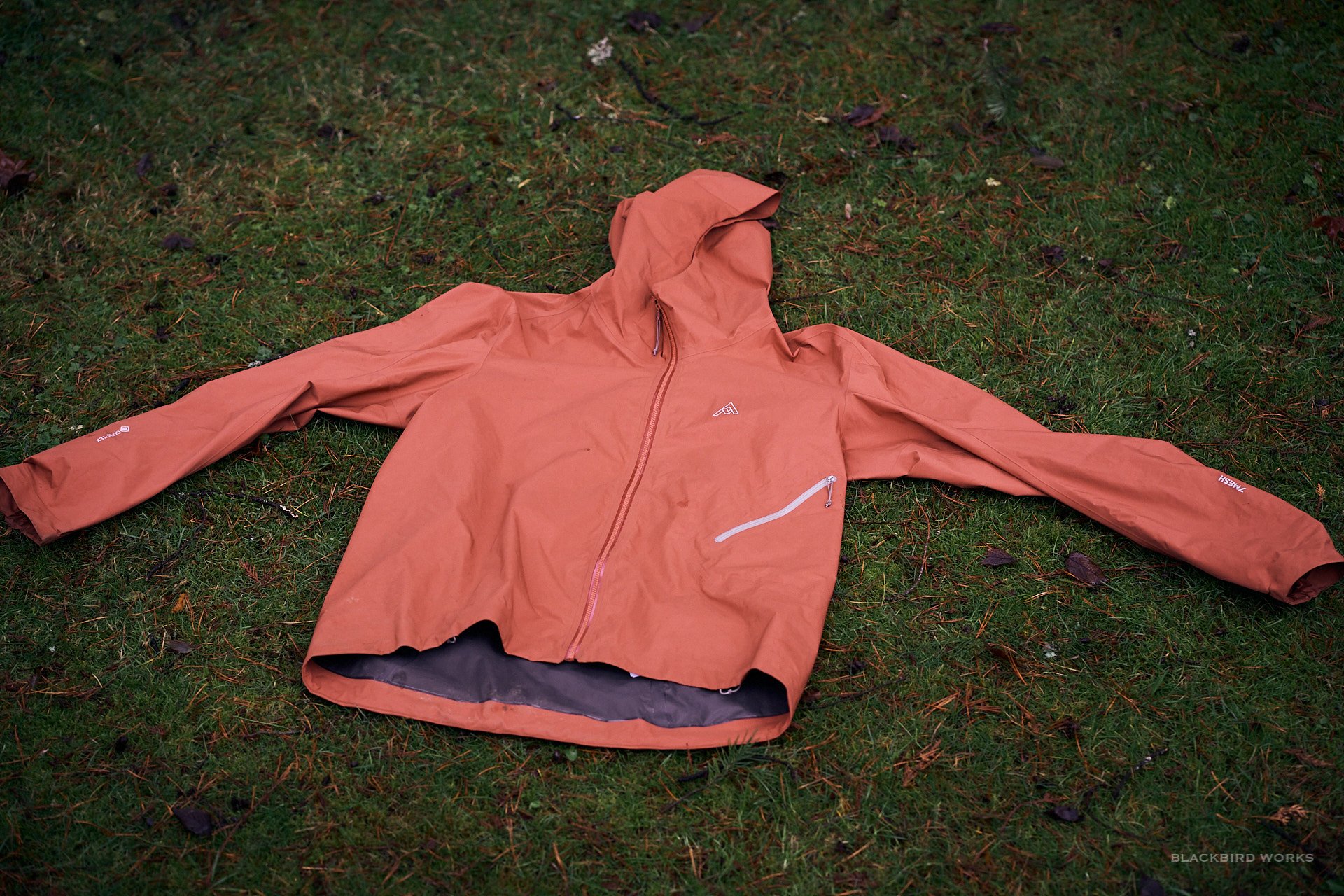
This is not exactly a 'how to build a jacket burrito' manual, but here's the Copilot as laid out. Do up the main zipper, then reach through one sleeve to the other side of the jacket, gathering material in your hand as you go.
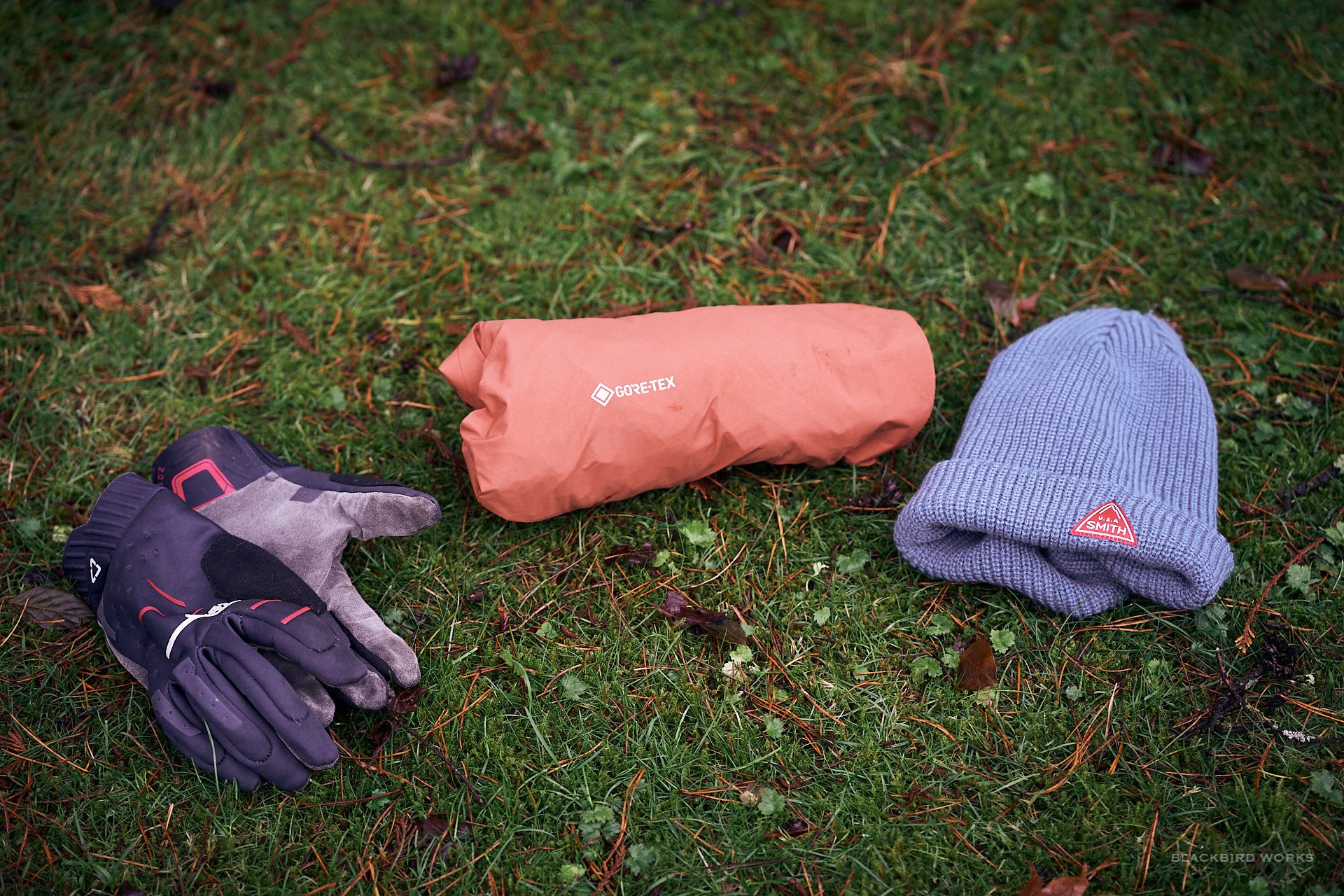
Pull the material back through the sleeve you reached into, and smooth it all into place. Voilà, your burrito is ready. It is recommended that you decline the 'wet burrito' option before putting it in your jersey pocket or bag.
GORE-TEX and the Certification Process
You can't just launch a brand and start using Gore-Tex - they have very strict guidelines for use of their textiles and you have to establish your design and manufacturing talents to even be able to buy the stuff. In a sense, that's good for the consumer - every product featuring Gore-Tex has already been vetted to ensure the membrane is being applied properly and will interface properly with seams, zippers, panels, etc. I've heard it can be a bitch to get them to certify a new design or technology until it's proven to them that it'll hold up in the real world. Again, that's good for all of us because you can think of GORE as being another level of QA, it just happens on the front end during the design process rather than after products roll off the line.
GORE-TEX Product Care
Most of us don't take care of our Gore-Tex garments very well - or at all. You may find this 2-minute expert article useful to gain a better understanding of How Gore-Tex works, and how to take care of it. But it can be summed up in even less than two minutes:
WASH. DRY. REPEAT OFTEN
- Machine Wash 40'C
- Do Not Bleach
- Tumble Dry Low
- Iron Low
- Do Not Dry Clean

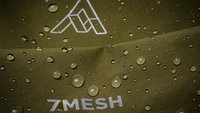
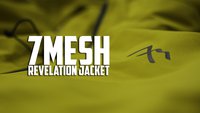








Comments
OldManBike
3 years, 2 months ago
Enjoying the mental image of all the mountain bike bros ironing their rain gear.
Reply
AJ Barlas
3 years, 2 months ago
What is this iron thing I hear of? 😉
Reply
Perry Schebel
3 years, 2 months ago
a thing you use for waxing snowboards.
Reply
AJ Barlas
3 years, 2 months ago
Ahhh, I remember those! Plenty of mild burns on the hand from them actually.
Reply
mrbrett
3 years, 2 months ago
The fact of it is that you need both a Paclite and a Pro jacket, just to cover the basics. And if you're headed to the coffee shop or grocery store in winter and select any fewer than three (3) pieces from the GoreTex Gallery, you can be fined.
Reply
Pete Roggeman
3 years, 2 months ago
Sarcasm aside (and fair play - too true!) one thing I've noticed is that people who live in wet coastal areas like ours wear sensible jackets to beat the rain when commuting or grocery shopping, rather than using umbrellas. I'm a fan of this, because people are about as good with umbrellas as they are with turn signals and other things involving common sense and courtesy to others. Also, I reckon if you live in these conditions and don't own a good waterproof jacket, you may be hibernating a bit too much when it rains. So I don't see all the fancy over-geared folks in the store as a bad thing - rather I assume most of them are getting double duty out of their sports gear.
Reply
Perry Schebel
3 years, 2 months ago
yep. good clothing makes the difference between complaining about the weather & enjoying the outside year round regardless of what the sky is doing.
Reply
mrbrett
3 years, 2 months ago
Oh yes, you do make a valid point about double duty. When I get a new jacket it starts the hierarchy as a casual social visit garment (remember those?), then biking, then work. As it gets more worn and beat it goes down the chain. So I do resemble my own sarcastic comment about Grocery Goretex after all. A Copilot would be a prime candidate for this usage case.
Reply
sansarret
3 years, 2 months ago
This doesn’t apply to this Jacket but I have both the Guardian with Gore-Tex Active and the Revelation with Gore Tex Pro. I use them for a 60km daily commute in Vancouver. Active is better suited to our climate, it keeps me dryer as it breathes much better while being just as waterproof.
Reply
Pete Roggeman
3 years, 2 months ago
That's a useful side-by-side comparison. In getting ready to write this piece, I realized that my knowledge of the various Gore-Tex options is not complete, which means most riders are likely in the same boat. I took a surface stab at explaining it a little bit, but I think there's room to go deeper. I also think that Gore and the brands that use it need to do more to explain these things. It is, admittedly, fairly technical and probably one or two levels deeper than most people want to go, but there's a lot of technology hidden beneath the surface of 3, 4, 5 and 600 dollar jackets and the more people understand about it, the better I think they can choose what they really need and also decide what level of investment makes sense for them.
Reply
Marty Zaleski
3 years, 2 months ago
I happen to own this very same jacket, right down to the colour and size. I’m Pete’s weight but three inches taller. Fit is perfect. Nice and light. Easy to layer so I’m just warm enough, even through this winter we’re having here in North Van. Doubles as a decent running or XC ski option when it’s inclement. If I find myself too wet, it’s not the jacket. No complaints.
Reply
khai
3 years, 2 months ago
One thing I adore about washing instructions is how they tend to say "wash at 40deg" - as if one's washer or dryer specifies what cold/warm/hot actually outputs. I've read that it's because the length of the line from the faucet to the machine impacts the temp, but it's still annoying. Typically I wash on "warm" and dry briefly (15-20min) on "hot" so that the piece is nicely warm but not hot when it comes out of the dryer.
I considered this piece when replacing my riding jacket but in the end opted for the Skypilot - which in combination with a pair of Revo shorts and some Shower's Pass waterproof merino socks have kept me warm and dry through many a ride in standard PNW winter conditions. The Skypilot packs down pretty well, though not quite as compact as this - but I figured since I live in a temperate rainforest, better to opt for the slightly burlier option.
Reply
AndrewR
3 years, 2 months ago
@khai European washing machines such as Bosch and Miele are actually that precise.
Reply
khai
3 years, 2 months ago
That may be the case. We own a pair of Euro machines - brand new Electrolux. It may wash at exactly 37.5deg on "warm" for all I know. NONE of the documentation says what the temps are. I think the Bosch has an internal heating element that allows it to be more precise with the temps. I don't know how important that might be. But I do know that (at least for the Electrolux machines) it's not listed in the manual. The same is true for the dryer.
Reply
ehfour
3 years, 1 month ago
@Pete- Have any thoughts on this jacket vs the Patagonia Dirt Roamer?
Reply
Please log in to leave a comment.